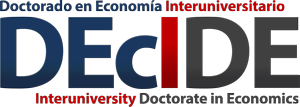- Referencia: Guilló, M.D. y Chrysanthou, G.: “The Dynamics of Heterogeneous Political Party Support and Egocentric Economic Evaluations: the Scottish Case”. 2018, European Journal Of Political Economy 52, 192-213.DOI:
We explore the dynamics of the Scottish National Party (SNP) support using the British Household Panel Survey (BHPS) during 1999-06. We study the relative importance of political sentiments and egocentric economic evaluations by disentangling the effects of state dependence and unobserved heterogeneity by gender. Egocentric economic evaluations constitute an important determinant of SNP support over the entire period, being this…
- Referencia: Martínez-Pérez, J.E., Sánchez-Martínez, F.I. y Abellán, J.M.: “Impacto de la Ley de Dependencia sobre el gasto autonómico en servicios sociales”. 2020, Gaceta Sanitaria, 34(1): 21-25.
Objetivo: En este trabajo se cuestiona si el desarrollo del Sistema de Autonomía y Atención a la Dependencia (SAAD) contribuyó a incrementar el volumen de recursos del sistema público de servicios sociales (efecto desplazamiento) o, por el contrario, si dicho desarrollo se produjo a costa del resto de prestaciones de servicios sociales (efecto sustitución). Método:…
- Referencia: Beyaert, A., García-Solanes, J. y López-Gómez, L.: “Do institutions of the euro area converge?”. 2019, Economic Systems, 43(3-4).
In this paper, we analyzes institutional convergence across eurozone economies with data of six institutional variables for the period December 1998- July 2018. The underlying motivation is that institutional factors, apart from affecting economic performance in the short-run, are key determinants of the long run per-capita income levels of the countries. We apply the third-generation…
- Referencia: Camacho, M. y Palmieri, G.: “Do economic recessions cause inequality to rise?”. 2019, Journal of Applied Economics, 22: 304-320..
We use a local projection approach to analyze the effect of economic recessions on income inequality in a comprehensive sample of 43 countries from 1960 to 2016. Although we consider both business-cycle and growth-cycle recessions, we fail to find evidence of significant positive impacts of economic downturns on income distribution, once controls are added to…
- Referencia: y Martínez-García, M.P.: “Resource effect in the Core–Periphery model”. 2019, Spatial Economic Analysis, 14(3): 339-360..
This paper develops an extension of Krugman’s Core–Periphery (CP) model by considering a competitive primary sector that extracts a renewable natural resource. The dynamics of the resource give rise to a new dispersion force: the resource effect. If primary goods are not tradable, lower trade costs boost dispersion, and the agglomeration–dispersion transition is sudden or…
- Referencia: y López-Lozano, J.M.: “A nonlinear time-series analysis approach to identify thresholds in associations between population antibiotic use and rates of resistance”. 2019, Nature Microbiology, 4: 1160-1172..
Balancing access to antibiotics with the control of antibiotic resistance is a global public health priority. At present, antibiotic stewardship is informed by a ‘use it and lose it’ principle, in which antibiotic use by the population is linearly related to resistance rates. However, theoretical and mathematical models suggest that use–resistance relationships are nonlinear. One…
- Referencia: y Nebot, C.A.: “New insights into the nonlinearity of the ECB Taylor Rule”. 2019, Applied Economics Letters, 26(12): 1044-1048.
We apply a non-parametric procedure, Multiple Adaptive Regression Splines (MARS), to endogenously select the best multiple threshold model for the European Central Bank (ECB) Taylor Rule (TR). MARS offers the advantage of not excluding simpler models if they better fit the data. On monthly data from 1/2000 to 9/2016, the TR exhibits thresholds for both…
- Referencia: Chen, G., García-Gordillo, M.A., Collado-Mateo, D., del Pozo-Cruz, B., Adsuar, J.C., Cordero-Ferrera, J.M., Abellán-Perpiñán, J.M. y Sánchez-Martínez, F.I.: “Converting Parkinson-Specific Scores into Health State Utilities to Assess Cost-Utility Analysis”. 2018, Patient, 11(6): 665-675.
Objectives. The aim of this study was to compare the Parkinson’s Disease Questionnaire-8 (PDQ-8) with three multi-attribute utility (MAU) instruments (EQ-5D-3L, EQ-5D-5L, and 15D) and to develop mapping algorithms that could be used to transform PDQ-8 scores into MAU scores. Methods. A cross-sectional study was conducted. A final sample of 228 evaluable patients was included…
- Referencia: Pinto-Prades, J.L., Sánchez-Martínez, F.I., Abellán-Perpiñán, J.M. y Martínez-Pérez, J.E.: “Reducing preference reversals: The role of preference imprecision and nontransparent methods”. 2018, Health Economics, 27(8): 1230-1246.
Preferences elicited with matching and choice usually diverge (as characterised by preference reversals), violating a basic rationality requirement, namely, procedure invariance. We report the results of an experiment that shows that preference reversals between matching (Standard Gamble in our case) and choice are reduced when the matching task is conducted using nontransparent methods. Our results…
- Referencia: Camacho, M y Palmieri, G.: “Latin American cycles: Has anything changed after the Great Recession?”. 2017, Emerging Markets Finance and Trade, 53: 1170-1183..
This paper analyzes the evolution of growth cycles and business cycles in Latin America from 1980 to 2013 by using monthly industrial production. Focusing on both synchronization and other cyclical features, we find evidence of significant cyclical links between the countries of the region, which seem to be highly integrated in this period. Notably, we…

